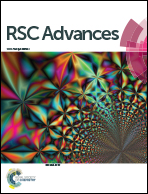Didymellanosine, a new decahydrofluorene analogue, and ascolactone C from Didymella sp. IEA-3B.1, an endophyte of Terminalia catappa†
Abstract
Didymellanosine (1), the first analogue of the decahydrofluorene-class of natural products bearing a 13-membered macrocyclic alkaloid conjugated with adenosine, and a new benzolactone derivative, ascolactone C (4) along with eight known compounds (2, 3, 5–10), were isolated from a solid rice fermentation of the endophytic fungus Didymella sp. IEA-3B.1 derived from the host plant Terminalia catappa. In addition, ascochitamine (11) was obtained when (NH4)2SO4 was added to rice medium and is reported here for the first time as a natural product. Didymellanosine (1) displayed strong activity against the murine lymphoma cell line L5178Y, Burkitt's lymphoma B cells (Ramos) and adult lymphoblastic leukemia T cells (Jurkat J16), with IC50 values of 2.0, 3.3 and 4.4 µM, respectively. When subjected to a NFκB inhibition assay, didymellanosine (1) moderately blocked NFκB activation in the triple-negative breast cancer cell line MDA-MB 231. In an antimicrobial assay, ascomylactam C (3) was the most active compound when tested against a panel of Gram-positive bacteria including drug-resistant strains with MICs of 3.1–6.3 µM, while 1 revealed weaker activity. Interestingly, both compounds were also found active against Gram-negative Acinetobacter baumannii with MICs of 3.1 µM, in the presence of a sublethal concentration (0.1 µM) of colistin.



 Please wait while we load your content...
Please wait while we load your content...